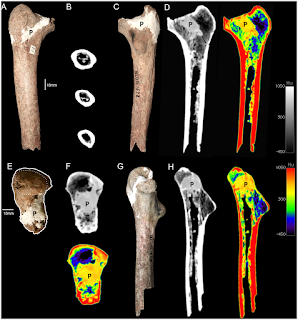 |
| Homo erectus Source: Wikipedia |
A point that's been made many times before here and elsewhere, but which creationists don't seem to be able to understand, is that science progresses essentially because nothing is ever completely ruled out and new evidence is always carefully examined before being accepted or rejected. If acceptance means we need to revise our previous understanding, then we revise our understanding. It would be a complete absurdity for science to know that there was evidence showing that our understanding was wrong yet to ignore it and pretend it just wasn't there.
This of course is in stark contrast to creationism where loons like Ken Ham are actually admired for dogmatically stating that no evidence can ever contradict what creationists 'know' because creationists 'know' the truth, and they didn't get it from the evidence. This dogma, which of course is essential for people trying to maintain a sacred conclusion with the evidence so strongly against them and being added to all the time, enabled creationists to simply wave aside contradictory evidence and still convince themselves that this intellectual dishonesty is a special virtue which any decent god would appreciate.
Abstract
The number of Late Pleistocene hominin species and the timing of their extinction are issues receiving renewed attention following genomic evidence for interbreeding between the ancestors of some living humans and archaic taxa. Yet, major gaps in the fossil record and uncertainties surrounding the age of key fossils have meant that these questions remain poorly understood. Here we describe and compare a highly unusual femur from Late Pleistocene sediments at Maludong (Yunnan), Southwest China, recovered along with cranial remains that exhibit a mixture of anatomically modern human and archaic traits. Our studies show that the Maludong femur has affinities to archaic hominins, especially Lower Pleistocene femora. However, the scarcity of later Middle and Late Pleistocene archaic remains in East Asia makes an assessment of systematically relevant character states difficult, warranting caution in assigning the specimen to a species at this time. The Maludong fossil probably samples an archaic population that survived until around 14,000 years ago in the biogeographically complex region of Southwest China.*
Curnoe D, Ji X, Liu W, Bao Z, Taçon PSC, Ren L (2015)
A Hominin Femur with Archaic Affinities from the Late Pleistocene of Southwest China.
PLoS ONE 10(12): e0143332. doi:10.1371/journal.pone.0143332
*© 2015 Curnoe et al.
Reprinted under the terms of the Creative Commons Attribution License (CC-BY 4.0)
The clue that this may be the remains of a cannibal meal is the fact that there are bones of other animals showing signs of having been butchered and cooked in a firem as the hominid femur does, but only the hominid femur has been painted with red ochre, a pigment made from clay which has been associated with ceremonial human burials.
The authors themselve urge caution but, if this find is substantiated, it will add yet another new hominid species to the Asian collection which included H. floresiensis (the 'Hobbit') which may be a dwarf form of H. erectus. It will mean we need to revise our understanding of when these archaic hominids died out and maybe to what extent they interbred with early moderns, since this places them as contemporaneous with early farming in China.
Science will now assess this evidence, look for other evidence with which to falsify of lend support to the new thinking, and adjust it's understanding accordingly, and out knowledge of the human evolutionary tree will advance and get closer to the truth.
'via Blog this'


I love your second paragraph. It describes creationists so well :)
ReplyDelete